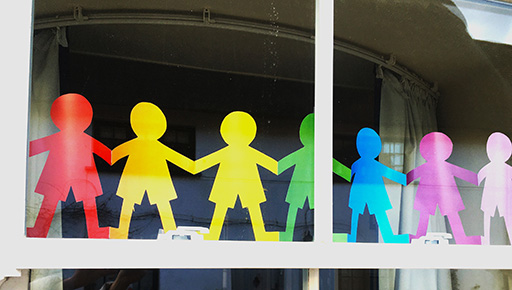3 Separated but connected
One striking difference you may notice between the past experiences of David and Michael and those of us socially isolating under the 2020 pandemic, is the degree of isolation they faced and the limited access they had to the outside world. This degree of access we have to the outside world can make a significant difference to our sense of social isolation as do opportunities for social interaction.
During the COVID-19 pandemic, people have a range of options and choices for communicating and staying connected, for example, through the internet, social media, video and audio apps. Not everyone, however, has the same levels of internet access or the skills to use these tools. Yet a range of innovative ways of communicating are emerging in countries around the world, such as displaying rainbows or hearts as symbols of hope or the use of red, amber, green cards in windows to indicate who is in need of help.
Shortly you will listen to the final audio conversation in this session. Here David and Michael discuss some of the different ways they found to communicate with others, despite their isolation. They also discuss the powerful personal impact of actions by others then and now, which help to keep us all connected and know that while isolated, we are not alone.
Audio 3 transcript (Word document) [Tip: hold Ctrl and click a link to open it in a new tab. (Hide tip)]
Activity 5 Staying connected
Take a moment to imagine that during the pandemic, the internet has been down for a week. Or because of your age or circumstances, you do not have the skills, means or opportunity to access the internet or a smartphone. You might like to have a conversation over the phone with someone who doesn’t use the internet or social media, to help you with this activity. Now note down your answers to the following questions.
- How might people connect with you in ways which do not rely on the internet? Try to list 2 or 3 suggestions.
- Is there anything you can do now to connect with people who may be isolated in your wider community?
Discussion
You might have considered a variety of ways of communicating safely, without the use of social media such as: using colour coding in windows, adapting the use of semaphore to your location, Morse code to communicate between houses using torches, collective storytelling from balconies, communal clapping, singing or more traditional mechanisms such as letter writing or landline phone calls. Some of these may provide opportunities for younger people to communicate with older relatives, neighbours or friends about what they did in the past and learning new skills.
Throughout this session you have explored different strategies for adjusting to isolation and confinement, managing the ‘elasticity of time’ and staying connected. You have also had an opportunity to reflect on the resources you have individually or as a family, household or community.
As you near the end of this session, here are some thoughts to keep hold of:
- Remember that change is challenging and you need time to adjust your mindset.
- Find ways to be proactive and take some control over your situation, no matter how limited.
- Create new routines to break up and manage your time.
- Keep your mind active – crosswords, learning a language, study, problem-solving.
- Build in some time for self-reflection to take stock.
- Note the victories – this could be hearing good news stories or making new contacts.
- Try to avoid the negative such as rolling news reports or ill-informed / irresponsible social media posts.
- Find creative ways for communicating with others who may be isolated in your community or elsewhere.
- Do something kind or useful for someone else. Making others happier will make you feel happier too!

